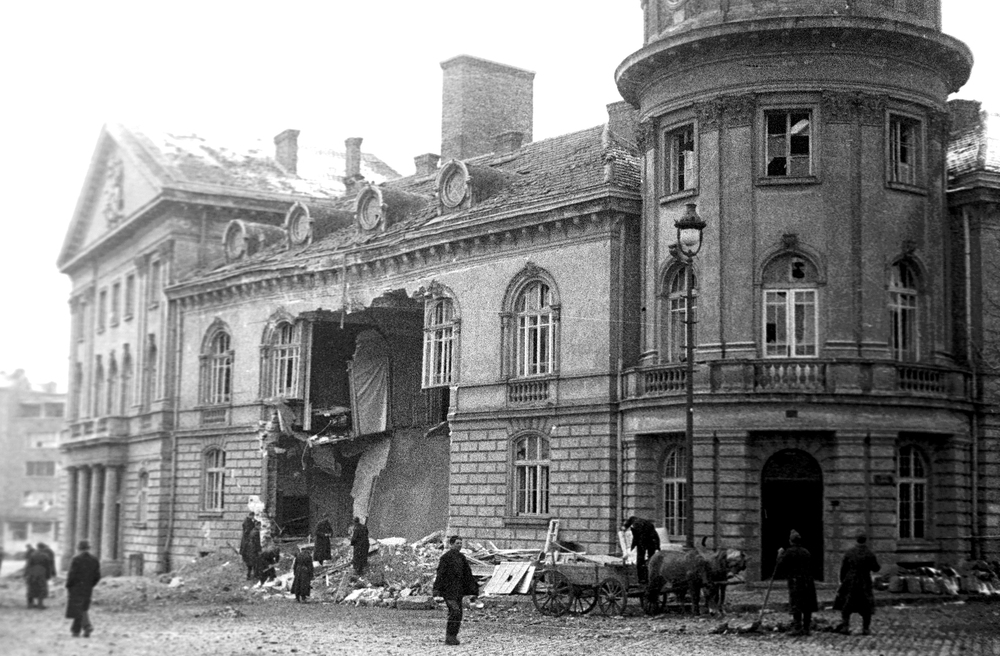site.btaNovember 14, 1943: Allies Escalate Air Offensive against Bulgaria


The Allied air offensive against Bulgaria during WW II escalated 82 years ago, on November 14, 1943. In this first massive strike, between 90 and 150 RAF bombers and fighters dropped 190 demolition bombs on Sofia, killing 56 persons, injuring nearly 200, and destroying 24 buildings.
The next heavy bombardment occurred on November 24, in which the USAF lost 4 planes before the attack and 12 on their way back to base in Southern Italy.
The Allied bombers came yet again in December 1943, when more than 200 people were killed and 345 were injured in the three raids during that month. On December 20, Bulgarian fighters downed three enemy bombers and seven fighters. The defenders lost of two aircraft, including one destroyed in a suicidal ramming attack by Captain Dimitar Spisarevski which brought down a USAF bomber.
In the worst air strike, on January 10, 1944, 200 B-17 and B-24 bombers and 80 Wellington bombers dropped some 1,400 bombs on the city centre in a 1.5-2 km carpet by 280 planes in five waves of 27-30 bombers each, killing some 750 people and wounding 1,100-plus, starting 37 major fires, and completely destroying 3,304 buildings and rendering another 472 uninhabitable. The Allies lost six of their B-17 Flying Fortress and B-24 Liberator bombers, and six Bulgarian aircraft were shot down. Over 300,000 people left the city in panic, and the government administration was paralyzed.
On the night of March 29 and the day of March 30, 1944 more than 450 B-17, B-24, Mitchel and Halifax bombers dropped 3,000-plus demolition and incendiary bombs on the city, killing 139 people and wounding an unknown number of Sofianites, destroying 3,675 residential and office buildings and starting more than 2,000 fires. In that raid, four Allied bombers and three fighters were shot down and another 10 bombers and 3 fighters were damaged.
The air campaign culminated on Easter Sunday, April 17, when 350-plus B-17 bombers attacked with 2,500 demolition bombs, killing 120 people, wounding another 76, and destroying 1,100 buildings in the city.
By April 1944, a total of 2,000 warplanes deployed by the US 15th Air Army and the 205th RAF in Operation Point Blank carried out seven day-time and five night-time air strikes on the capital with 8,800 fuse and several thousand incendiary bombs totalling 435 tonnes. Hitting mostly civilian targets, they killed 1,828 and wounded 2,477 Sofianites. Some 12,567 residential, industrial and public buildings were destroyed (of which 2,670 razed to the ground), including the Sofia Library with its 40,000 books. The Council of Ministers, the National Assembly, the Bulgarian Academy of Sciences, the Holy Synod of the Bulgarian Orthodox Church, the Archaeological Museum, the State Printing House, the St Joseph Catholic Cathedral and the National Theatre, among others, were affected as well.
Between April 1941 and September 1944, Yugoslav, US, British and Soviet aircraft carried out more than 23,000 daytime and nighttime air strikes on 168 Bulgarian settlements, dropping nearly 50,000 aerial bombs, killing 4,208 people and injuring 4,744 (mainly civilians).
In the raids, the Allies lost an aggregate 147 aircraft, of which 65 were shot down by Bulgarian fighters, and Bulgaria lost 22 aircraft. A total of 141 USAF and RAF servicemen were killed in the air campaign, and 329 were taken prisoner.
The air campaign was intended basically to force the Bulgarian Government to sever its military-political alliance with the Third Reich and withdraw its troops from Yugoslav and Greek territory. The bombing responded to Sofia's accession to the Tripartite Pact (Germany, Italy and Japan) on March 1, 1941 and followed Bulgaria's declaration of war on the US and Britain on December 13, 1914. British Prime Minister Winston Churchill defined razing Sofia off the map as a most important strategic task of the spring of 1944.
/LG/
news.modal.header
news.modal.text